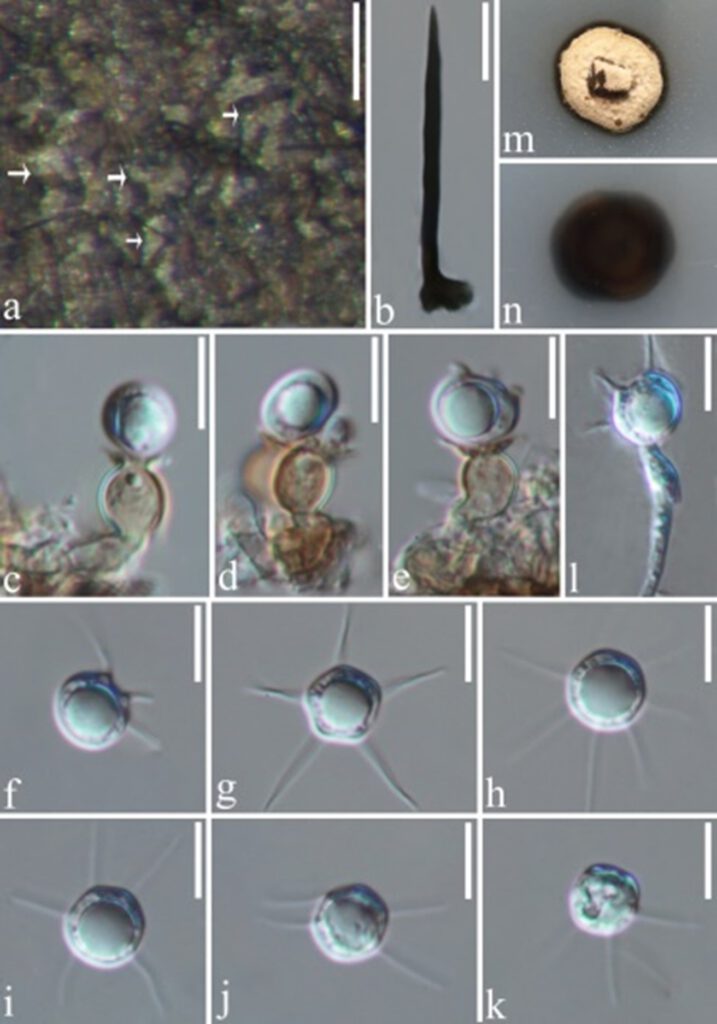Paragaeumannomyces guttulata J.Y. Zhang, Y.Z. Lu & K.D. Hyde sp. nov. (Figure 8).
MycoBank number: MB; Index Fungorum number: IF; Facesoffungi number: FoF 11041;
Etymology: Referring to its conidia with big guttules.
Holotype: HKAS xxx
Saprobic on dead bamboo culms in freshwater habitats. Sexual morph: Undetermined. Asexual morph: hyphomycetous. Colonies on natural substrate superficial, effuse, gregarious. Mycelium composed of partly immersed, partly superficial, septate, pale brown. Setae scattered over entire colonies, aseptate, dark brown, stiff, pointed, 65–110.5 μm long (x̅ = 85 μm, n = 13). Conidiophores often reduced to conidiogenous cells, semi-macronematous to micronematous, mononematous, flexuous, unbranched, pale to moderately brown, thin-walled. Conidiogenous cells 6.4–10.3 × 5.4–8 μm (x̅ = 8 × 6.5 µm, n = 20), monophialidic, flask-shaped, cup-shaped collarette, hyaline to light brown, guttulata. Conidia 9.4–11.5 μm diam. (x̅ =10.5 μm, n = 30), enteroblastic, acrogenous, aseptate, hyaline, globose to subglobose or ellipsoid, guttulate, with 2–6 hair-like and 8.8–13.5 µm long appendages.
Culture characteristics: Conidia germinating on PDA within 15h, and the hyaline germ tubes germinates from a point of the conidia. Colonies on MEA at 26℃, slow growth, reaching 5 mm diam. in 30 days, circular, flat, with entire margin, taupe brown from above, while dark brown in reverse, and not producing pigmentation in culture.
Material examined: CHINA, Guizhou province, Zunyi city, Chishui county, Hushi town, Chishui Alsophila Natural Reserve (28°29’43”N, 106°0’24”E), on dead bamboo culms from a freshwater stream, 22 September 2019, J.Y. Zhang, Y132 (HKAS xxx, holotype; GZAAS 22-0076, isotype); ex-type living culture, GZCC 22-0084.
GenBank accession numbers: (LSU) xxx, (ITS) xxx.
Notes: Following BLASTn searches, the closest matches of Paragaeumannomyces guttulata are Chaetosphaeria panamensis (LSU, MT118218, 98.46% shared identity; ITS, KY212752, 92.68%). The phylogenetic results confirmed that our new isolate formed a separate clade within the genus Paragaeumannomyces and shared a sister relationship with P. panamensis with well support (92% ML/1.0 PP, Figure 1). C. panamensis was introduced by Huhndorf and Fernández (2005) with sexual and asexual morph. Later, to be in line with the phylogenetic result and generic concept, Chaetosphaeria panamensis was transferred to genus Paragaeumannomyces (Réblová et al. 2020). Morphologically, our new species of P. guttulata formed an asexual morph in the natural substrate and is similar to P. panamensis in having Craspedodidymum-like anamorph. However, P. guttulata differs from P. panamensis in having bigger Conidiogenous cells and smaller and more round conidia with longer appendages (Huhndorf and Fernández 2005; Perera et al. 2016). We, therefore, introduced P. guttulata as a new species based on the evidences of morphology and phylogeny.

Figure 8. Paragaeumannomyces guttulata (HKAS xx, holotype). (a) Conlonies on host surface; (b) seta; (c-e) Conidiogenous cell with conidia; (f-k) Conidia; (l) Germinating conidium; (m-n) Colonies on PDA from above and below. Scale bars: (a) 100 μm; (b) 20 μm; (c-l) 10 μm
